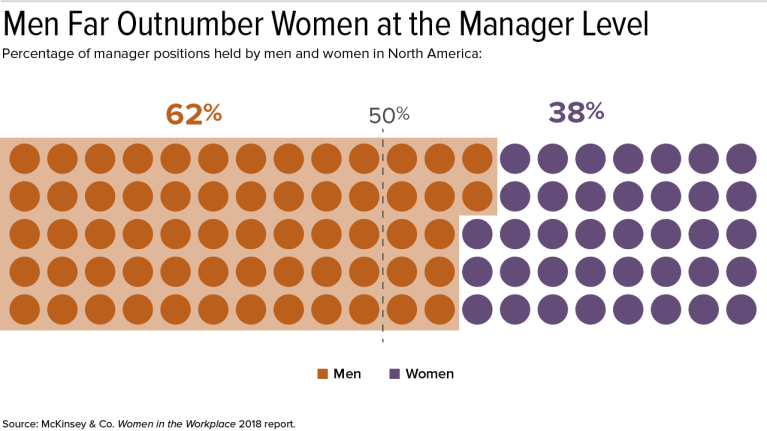Top Corporate Roles Are Rarely Held by Women
Experts recommend steps for seeking out, hiring women for C-suite spots

Susan Zirinsky became the first female president of CBS News in January. Maggie Timoney, named in December as CEO of Heineken USA, is the first woman to lead a major U.S. beer supplier. In May, Joanna Geraghty took on the No. 2 job at JetBlue Airways as its president and chief operating officer.
They are a rare sight: women in top leadership roles.
A study by executive search firm Heidrick & Struggles―the findings of which were released in December in Route to the Top 2018―found that women held 4.9 percent of the top roles in organizations across 13 countries. Female representation in the CEO role ranged from 6.9 percent in the U.S. to zero in Denmark and Italy.
At companies listed on the Standard & Poor's 500 index, women hold 26.5 percent of executive, senior-level and managerial positions but make up less than 5 percent of CEOs, according to a 2018 Catalyst survey.
And a 2016 DiscoverOrg diversity report found that women held less than 10 percent of the four most-senior-level roles—chairman of the board, chief executive officer, chief operating officer and chief financial officer―most commonly found at a Fortune 1000 company. However, 62 percent of the women in these top roles are chief executives in HR, and 48 percent are chief marketing officers.
Women, particularly women of color, "remain significantly underrepresented" in the corporate pipeline, according to "Women in the Workplace 2018." The report is from McKinsey & Co. in partnership with LeanIn.org and is based on data from 279 companies across North America.
Overcoming Obstacles to Leadership Equity
Companies need to treat gender diversity like the business priority it is, the McKinsey study noted. Its data is based on information from companies that collectively employ more than 13 million people. The organizations shared their pipeline data and completed a survey of their HR practices.
Additionally, more than 64,000 employees were surveyed on their workplace experiences, and women of different races and ethnicities and those identifying as LGBTQ were interviewed.
[SHRM members-only toolkit: Developing Organizational Leaders]
The study suggests organizations take the following steps to achieve leadership parity when hiring, reviewing the performance of and promoting diverse employees:
- Set diversity targets for hiring and promotions.
- Use automated resume-screening tools to reduce bias in hiring.
- Require diverse slates of candidates for hiring and promotions.
"Recruiters have networks in their database, and they go to the same well over and over and they track with candidates over [a candidate's] career," Stickney said. "They don't always make sure their network of potential candidates is different than the ones they've been presenting. It's important for companies to push back." - Set clear, consistent evaluation criteria for hiring and promotions before the process begins.
- Require unconscious-bias training for employees involved in hiring, reviewing and promoting workers.
- Provide reminders about how to avoid unconscious bias before the hiring, reviewing and promotion process begins.
- Track outcomes to check for bias. Parity.org offers a free ParityIndex to measure, rank and benchmark all companies within their industries on the gender balance of their C-suite and board of directors. Results are private and shown in real time, and there is a "what if" calculator to show how an organization's score can improve as it reaches gender parity.

Other Strategies
Interacting with senior leaders also can influence whether a career stalls or is headed in an upward trajectory. Employees who regularly interact with senior leaders—even in casual conversations or lunch meetings—are more likely to ask for and receive promotions and to aspire to be leaders in the organization. However, women get less access to senior leaders than men have, the McKinsey report found.
Cisco's Multiplier Effect program challenges leaders in the tech industry to pledge to sponsor one person—someone of a different race, culture, ability, gender, generation, ethnicity or sexual orientation—to advance to the next level. The idea is to create a multiplier effect by building a diverse pipeline at every level in the industry.
Procter & Gamble's Men Advocating Real Change (MARC) program enlists male employees as diversity champions and hosts regular workshops for program participants. The company also has a Women's Accelerator Program and Athena in Action initiatives to help high-potential women develop skills necessary for success in senior-level roles.
A growing number of organizations are signing the Paradigm for Parity pledge to commit to achieving gender parity in senior leadership by 2030 and develop women and minorities who can step into leadership roles. The coalition, launched in 2016, is made up of CEOs, senior executives, founders, board members and business academics committed to gender equity in senior executive roles and on corporate boards.
Signatories agree to:
- Minimize or eliminate unconscious bias. Unconscious-bias training and inclusion training are among the strategies to do this.
- Significantly increase the number of women in senior operating roles.
- Measure targets at every level and regularly communicate progress and results. Hold the entire senior team accountable to gain meaningful progress.
- Base career progress on business results and performance, not on time spent in the office. This allows employees control over where and how they work whenever feasible.
- Identify women with leadership potential and provide them with mentors and sponsors. Men have a critical role to play in advocating for women internally and in the wider corporate world.
"Often HR is educating across and down" within the organization. "What would be great is if HR and leaders for diversity and inclusion were educating … the C-suite and even the board."
Best Practices for Improving Gender Diversity
| | | % of U.S. Companies That Do This |
| ☐ | Track representation by: | |
| | Gender | 96% |
| | Race | 79% |
| | Gender and race combined | |
| ☐ | Track representation by: | |
| | Gender | 38% |
| | Race | 32% |
| | Gender and race combined | 10% |
| ☐ | Share most gender-diversity metrics with employees | 12% |
| ☐ | Hold senior leaders accountable for progress on gender-diversity metrics | 42% |
| ☐ | Hold managers and directors accountable for progress on gender-diversity metrics | 16% |
Steps for Minimizing Bias in Hiring, Performance Reviews and Promotions
| | | Hiring | Reviews & Promotions |
| | | % of North American Companies That Do This | |
| ☐ | Set diversity targets | 29% for gender 9% for gender and race combined | 21% for gender 8% for gender and race combined |
| ☐ | Use automated resume-screening tools to reduce bias | 23% | N/A |
| ☐ | Require diverse slates of candidates to be considered | 48% | 26% |
| ☐ | Set clear, consistent evaluation criteria before the process begins | 72% | 71% |
| ☐ | Require unconscious-bias training for employees involved | 36% | 32% |
| ☐ | Track outcomes to check for bias | 78% for gender 35% for gender and race combined | 42% for gender 18% for gender and race combined |
Advertisement
An organization run by AI is not a futuristic concept. Such technology is already a part of many workplaces and will continue to shape the labor market and HR. Here's how employers and employees can successfully manage generative AI and other AI-powered systems.
Advertisement


